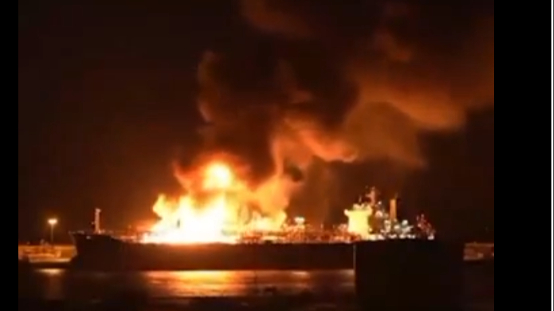By Stefan Korshak
Copyright kyivpost

Ukraine’s avowed campaign to destroy all Russian oil production capacity zeroed in on President Vladimir Putin’s hometown of St. Petersburg over the weekend. Punishing drone attacks hit an oil refinery, sanctioned oil tankers and the seaport in which they were tied up along with a fuel train in a daring behind-the-lines commando raid.
Starting late on Friday night operators from Ukraine’s 14th Unmanned Aircraft Regiment kicked off one of the most massive swarm air raids of the entire war, over the next four hours launching 220-230 long-range drones at targets across Russia. Approximately 30 kamikaze drones headed for Russia’s northwestern Leningrad region, and shortly after midnight dived one after the other on the Primorsk oil-pumping station.
In past strikes over 800-kilometer (500-mile) distances Ukraine has most often used the UJ-22 Liutyi drone – a precision guided, propeller driven aircraft with a 75-kilogram (165-pound) warhead. The type of drone used in this attack was not made public.
The Primorsk facility transfers crude oil delivered by pipeline from Russia’s interior to the nearby Ust-Luga port, where product is loaded aboard tankers of Moscow’s notorious “shadow fleet.” Ust-Luga is a major Russian outlet for energy exports via the Baltic Sea.
Leningrad’s regional governor Aleksandr Drozdenko reassured voters in a Telegram statement that all but two of the drones were shot down and claimed ground damage was minimal, saying “authorities have the situation under control.”
Russian media citing local sources told a different story, reporting that Ukrainian drones had hit and damaged two massive crude oil tankers tied up at the Primorsk terminal, as well as on-shore loading equipment that was pumping diesel onto a smaller ship.
The vessels were identified as the 105,000-ton, Sierra Leone flagged “Kusto;” the 109,000-ton, Sierra Leone flagged Cai Yun; and the 51,000-ton Phosphor, out of Hong Kong.
All three ships have failed to move from the Primorsk piers since Friday, according to data published by the ship-tracking group marinetraffic.com on Monday.
Osint satellite images of two tankers and a fuel transporter (Phosphor) at Primorsk port, image published on Sunday.
Video of a drone attack that purportedly took place at Primorsk saw an unidentified tanker hit amidships followed by a powerful orange explosion. According to industry reports, the tanker Kusto was most heavily damaged with 28 crew being forced to abandon the vessel. No casualties were reported.
The Ukrainian military information tracking group Strike News on Monday reported two of the four loading stations (berths 1 and 3) at the Primorsk terminal used for crude oil transfers ceased operation on Friday and added that the Kusto was fully loaded when hit.
Ukrainian energy industry reporter Petro Andriushchenko in his analysis on Monday said damage to onshore pipelines and pumping equipment had probably cut Primorsk’s loading capacity by as much as 50 percent. Vessel tracking data reviewed by Kyiv Post confirmed limited ship movement at the terminal.
The Kusto and Cai Yun are shadow fleet tankers sanctioned by Great Britain, the European Union and Canada – oil transport vessels used by Russia to evade oil export sanctions.
The Kremlin has blamed Ukrainian special forces frogmen of carrying out limpet mine attacks against Russian oil tankers, with underwater explosions hitting ships tied up in the ports of Ceyan in Turkey, Ust-Luga in Russia, Savona in Italy, and offshore near Libya.
Kyiv has not taken responsibility for the attacks, but Ukrainian intelligence agency officials have said Russia’s shadow tanker fleet would be attacked wherever and whenever possible.
The Primorsk strike marked the first confirmed Ukrainian strike by long-range drones, against sanctioned tankers carrying Russian oil.
Two nights later, on Sept. 14, Ukraine launched a reported 80-90 drones at targets across Russia, of which at least three struck the Kirishi (KINEF) oil refinery, some 100 kilometers (60 miles) southeast of St. Petersburg.
The plant processes 17-20 million tons of oil annually and accounts for about six percent of all of Russia’s refining capacity. The facility is a main supplier of petroleum-based products to St. Petersburg, Russia’s second-wealthiest city, and the surrounding Leningrad, Novgorod and Pskov regions.
At least two drones hit the refinery’s main distillation (cracking) tower and set it ablaze in a fiery mushroom cloud explosion. Firefighters claimed to have extinguished the fire later in the day.
Governor Drozdenko said all the Ukrainian drones were shot down and that falling debris from one of them had ignited a minor fire that was soon put out. Satellite images reviewed by Kyiv Post showed structural damage to refinery fuel storage and processing units.
In another strike targeting St. Petersburg’s energy industry infrastructure, operators from Ukraine’s security service SBU and the army intelligence agency HUR used explosives to blow up a loaded fuel train moving on the Orel-St. Petersburg railroad overnight on Saturday-Sunday.
Two train guards died, and a third railroad worker was severely injured in the blast stopping traffic both ways on the major trunk line for at least 24 hours. The train detonated mines placed on the track by behind-the-lines operators, a HUR statement said. Images published by local media showed wrecked locomotives and 15 fuel cars knocked off the tracks.
Ukrainian President Volodymyr Zelensky in Sunday evening comments said: “The most effective sanctions – the ones that work the fastest – are the fires at Russia’s oil refineries, its terminals, oil depots. We have significantly restricted Russia’s oil industry, and this significantly restricts the war. Russia’s war is essentially a function of oil, of gas, of all its other energy resources. I thank the special forces of the Security Service of Ukraine, who did a great job in Primorsk recently, hitting Russia’s largest oil terminal on the Baltic Sea. There is substantial damage; everything has been verified.”
Russia’s Baltic Sea port of Primorsk has a reported capacity of 50-60 million tons of oil annually. The neighboring Ust-Luga oil export terminal has a capacity of 30 million tons annually. Together, in peacetime, the two ports handle about 15 percent of all of Russia’s total seaborne energy product exports, worth between $20-30 billion annually. Ukrainian strikes over the past have roughly cut that flow in half, Russian energy industry reports say.
In August 2025 Ukraine kicked off a drone bombardment campaign prioritizing Russian energy infrastructure. Since then, at least 45 air raids by kamikaze drone have taken place – according to observers – probably hitting 22 oil and gas production, storage or transport facilities. More than a dozen major rail hubs as well as military industry, airfields and army headquarters also have been hit.
Kremlin spokesmen have accused Ukraine of attacking Russian civilians. As of mid-September, retail fuel shortages, spiking prices and even empty fuel stations had been reported in Russia’s Pacific, east and central Siberian regions, as well as in southwest Russia, the Volga River basin, and regions outlying Moscow and St. Petersburg.



